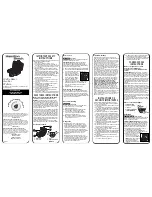
PRACTICAL ADVICE
Bread preparation is very sensitive to temperature and humidity conditions.
In case of high heat,
use liquids that are cooler than usual. Likewise, if it is cold, it may be necessary to warm up the water or
milk (never exceeding 35°C). Any liquid used should be tepid, about 20 to 25 C (except for Super Fast
Bread which should be 35 to 40 C max.).
It can also sometimes be useful to check the state of the dough during the second kneading:
it should form an even ball which comes away easily from the walls of the pan.
>
if not all of the flour has been blended into the dough, add a little more water,
>
if the dough is too wet and sticks to the sides, you may need to add a little flour.
Such corrections should be undertaken very gradually (no more than 1 tablespoon at a time) and wait to
see if there is an improvement before continuing.
A common error is to think that adding more yeast will make the bread rise more.
Too much yeast
makes the structure of the bread more fragile and it will rise a lot and then fall while baking. You can deter-
mine the state of the dough just before baking by touching it lightly with your fingertips: the dough should
be slightly resistant and the fingerprint should disappear little by little.
Adding oats, bran, wheat germ, rye or whole grains to the bread dough will give a smaller, heavier loaf of
bread.
Using T55 flour is recommended unless otherwise specified in the recipe.
Sifting the flour also affects the results: the more the flour is whole (i.e. the more of the outer envelope of
the wheat it contains), the less the dough will rise and the denser the bread. You can also find ready-
to-use bread preparations on the market. Follow the manufacturer’s instructions when using these
preparations. Usually, the choice of the programme will depend on the preparation used. For example:
Wholemeal bread - Programme 3.
Sugar:
use white sugar, brown sugar or honey. Do not use unrefined sugar or lumps. Sugar acts as food
for the yeast, gives the bread its good taste and improves browning of the crust. Artificial sweeteners can-
not be substituted for sugar as the yeast will not react with them.
Salt:
salt gives taste to food and regulates the yeast’s activity. It should not come into contact with the
yeast. Thanks to salt, the dough is firm, compact and does not rise too quickly. It also improves the
structure of the dough. Use ordinary table salt. Do not use coarse salt or salt substitutes.
Yeast:
yeast is what makes the dough rise. Use active dry baker’s yeast in packets. The quality of
yeast can vary, and it does not always rise in the same way. Bread can therefore come out differently
depending on the yeast used.
Old or poorly stored yeast will not work as well as a freshly opened packet of dry yeast.
The proportions indicated are for flaked dried yeast. If you use fresh yeast, multiply the quantity by 3 (in
weight) and dilute the yeast in a small amount of warm water with a little sugar for more effective action.
There are dry yeasts in the form of small granular pellets that have to be rehydrated with a small amount
of warm water with a little sugar. These are used in the same proportions as flaked dry yeast, but we
recommend the latter as it is easier to use.
Additives
(olives, bacon pieces, etc.)
:
you can add a personal touch to your recipes by adding
whatever ingredients you want, taking care:
>
to add following the beep for additional ingredients, especially those that are fragile such as dried fruit,
>
to add the most solid grains (such as linseed or sesame) at the start of the kneading process to facilitate
use of the machine (delayed starting, for example),
>
to thoroughly drain moist ingredients (olives),
>
to lightly flour fatty ingredients for better blending,
>
not to add too large a quantity of additional ingredients, especially cheese, fresh fruit
and fresh vegetables, as they can affect the development of the dough,
>
to finely chop nuts as they can cut through the loaf structure and reduce the cooked height.
21
OW3000 MOULI ref 3313488 19/07/06 14:26 Page 22































